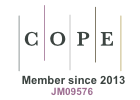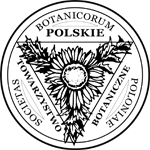New Records of Rare Hypogeous Fungi from Poland (Central Europe)
Abstract
Keywords
References
Picoa carthusiana Tul. (2020). Datenbank der Pilze Österreichs. Retrieved July 8, 2020, from http://austria.mykodata.net/Taxa_sites.aspx?qvtaxIdTaxon=277438
Agerer, R. (2006). Fungal relationships and structural identity of their ectomycorrhizae. Mycological Progress, 5, 67–107. https://doi.org/10.1007/s11557-006-0505-x
Alvarado, P., Cabero, J., Moreno, G., Bratek, Z., Vooren, N. V., Kaounas, V., Konstantinidis, G., Agnello, C., Merényi, Z., Smith, M., Vizzini, A., & Trappe, J. M. (2016). Phylogenetic overview of the genus Genea (Pezizales, Ascomycota) with an emphasis on European taxa. Mycologia, 108(2), 441–456. https://doi.org/10.3852/15-199
Base de Jacques Trimbach (Picoa carthusiana). (2020). MycoDB. Retrieved July 8, 2020, from https://www.mycodb.fr/trimbachfull.php?query=Picoa%20carthusiana&action= search
Béres, M. (1999). Data to the vegetation of mushrooms in the Upper-Tisa Region. Tisia Monograph Series, 4, 293–307.
Bincoletto, A. (2014). Un raro Rhizopogon del piano alpino: R. melanogastroides [A rare Rhizopogon from the Alpine zone: R. melanogastroides]. In M. D. Maggiora, L. Gori, & U. Pera (Eds.), Atti di Convegno Micologico Nazionale di ricerca e studio dei funghi ipogei della Lucchesia [Proceedings of the national mycological conference on research and study of hypogeous fungi of Lucchesia] (pp. 43–47). Gruppo Micologico “M. Danesi”.
Binder, M., & Hibbett, D. S. (2006). Molecular systematics and biological diversification of Boletales. Mycologia, 98(6), 971–981. https://doi.org/10.1080/15572536.2006.11832626
Bratek, Z., Merényi, Z., & Varga, T. (2013). Changes of hypogeous funga in the Carpathian-Pannonian region in the past centuries. Acta Mycologica, 48(1), 33–39. https://doi.org/10.5586/am.2013.005
Chachuła, P. (2018). Grzyby wielkoowocnikowe Dłubniańskiego Parku Krajobrazowego – wstępne wyniki badań [Macrofungi in the Dłubnia Landscape Park – Preliminary results]. Przegląd Przyrodniczy, 29(2), 58–71.
Chachuła, P., Fiedor, M., Rutkowski, R., & Dorda, A. (2020). New records to the mycobiota of the Cieszyn municipality (Polish Western Carpathians) including new species for Poland. Acta Mycologica, 55(1), Article 5511. https://doi.org/10.5586/am.5511
Chmiel, A. (2006). Checklist of Polish Larger Ascomycetes. W. Szafer Institute of Botany, Polish Academy of Sciences.
Eckblad, F. E., & Lange, M. (1997). Melanogastrales Svrček. In L. Hansen & H. Knudsen (Eds.), Nordic Macromycetes (Vol. 3, pp. 294–295). Nordsvamp.
Flammer, R. (2011). St. Galler Hypogäen [Hypogeous fungi of St. Gallen]. Schweizerische Zeitschrift für Pilzkunde, 89(2), 66–67.
Gierczyk, B., Kujawa, A., Szczepkowski, A., Ślusarczyk, T., Pachlewski, T., Chachuła, P., & Domian, G. (2019). Macrofungi of the Bieszczady Mountains. Acta Mycologica, 54(2), Article 1124. http://doi.org/10.5586/am.1124
Glejdura, S. (2013). Nové nálezy bazídiových a vreckatých húb v Stolických vrchoch (Slovensko) [New records of basidiomycetes and ascomycetes in the Stolické vrchy (Slovakia)]. Mykologické Listy, 124, 15–40.
Hilszczańska, D., Rosa-Gruszecka, A., Sikora, K., & Szmidla, H. (2013). First report of Tuber macrosporum occurrence in Poland. Scientific Research and Essays, 8(23), 1096–1099.
Hilszczańska, D., Rosa-Gruszecka, A., & Szmidla, H. (2014). Characteristic of Tuber spp. localities in natural stands with emphasis on plant species composition. Acta Mycologica, 49(2), 267–277. http://doi.org/10.5586/am.2014.024
Hilszczańska, D., Sierota, Z., & Palenzona, M. (2008). New Tuber species found in Poland. Mycorrhiza, 18, 223–226. https://doi.org/10.1007/s00572-008-0175-4
Kers, L. E. (1986). Några Norska fynd av hypogéer [Some Norwegian findings of hypogeous fungi]. Agarica, 7(14), 30–48.
Knudsen, H. (2012). Alpova C. W. Dodge. In H. Knudsen & J. Vesterholt (Eds.), Funga Nordica. Agaricoid, boletoid, clavarioid, cyphelloid and gasteroid genera (p. 212). Nordsvamp.
Kozak, M., Mleczko, P., & Ławrynowicz, M. (2013). The problem of rarity of hypogeous fungi on the example of Octaviania asterosperma and Chamonixia caespitosa (Boletales). In A. Biedunkiewicz & M. Dynowska (Eds.), 56. Zjazd Polskiego Towarzystwa Botanicznego, Olsztyn, 24–30 czerwca 2013. Streszczenia wystąpień ustnych i plakatów [56 Conference of the Polish Botanical Society, Olsztyn, 24–30 June 2013. Abstracts of oral and poster presentations] (pp. 327–328). Polish Botanical Society.
Kujawa, A., & Gierczyk, B. (2011). Rejestr gatunków grzybów chronionych i zagrożonych w Polsce. Część IV. Wykaz gatunków przyjętych do rejestru w 2008 roku [Register of protected and endangered fungi species in Poland. Part IV. A list of species recorded in 2009]. Przegląd Przyrodniczy, 22(1), 17–83.
Kujawa, A., & Gierczyk, B. (2013). Rejestr gatunków grzybów chronionych i zagrożonych w Polsce. Część VII. Wykaz gatunków przyjętych do rejestru w 2011 roku [Register of protected and endangered fungi species in Poland. Part VII. A list of species recorded in 2011]. Przegląd Przyrodniczy, 24(2), 3–44.
Lange, M. (1957). Rhizopogon melanogastroides n. sp. Sydowia, 1, 255–256.
Ławrynowicz, M. (1988). Ascomycetes, Elaphomycetales, Tuberales. Flora Polska, Grzyby [Flora of Poland, Fungi] (Vol. 18). Państwowe Wydawnictwo Naukowe.
Ławrynowicz, M. (2009). Four Tuber species accompanying T. mesentericum in natural sites in Poland. Anales del Jardín Botanico de Madrid, 66S1, 145–149. https://doi.org/10.3989/ajbm.2227
Ławrynowicz, M., Krzyszczyk, T., & Fałdziński, M. (2008). Occurrence of black truffles in Poland. Acta Mycologica, 43(2), 143–151. https://doi.org/10.5586/am.2008.018
Martín, M. P. (1996). The genus Rhizopogon in Europe. Catalonian Mycological Society.
Martín, M. P. (2001). Chorologic database of European Rhizopogon species. Mycotaxon, 78, 191–244.
Martín, M. P., & Raidl, S. (2002). The taxonomic position of Rhizopogon melanogastroides (Boletales). Mycotaxon, 84, 221–228.
Mleczko, P., Kozak, M., Ławrynowicz, M., & Dubiel, G. (2010). Octaviania asterosperma (hypogeous Basidiomycota). Recent data to ecology and distribution. Acta Mycologica, 45(2), 133–144. https://doi.org/10.5586/am.2010.017
Mleczko, P., Kozak, M., Ławrynowicz, M., & Górszczyk, A. (2009). New localities of Chamonixia caespitosa (hypogeous Boletaceae) in Central Europe. Acta Mycologica, 44(1), 29–42. https://doi.org/10.5586/am.2009.005
Montecchi, A., & Lazzari, G. (1989). Melanogastraceae species collected in the Appennino Reggiano-Parmense area. Micologia Italiana, 18(2), 33–48.
Montecchi, A., & Sarasini, M. (2000). Funghi ipogei d’Europa [European hypogeous fungi]. Associazione Micologica Bresadola; Fondazione Centro Studi Micologici.
Moreau, P. A., Rochet, J., Richard, F., Chassagne, F., Manzi, S., & Gardes, M. (2011). Taxonomy of Alnus-associated hypogeous species of Alpova and Melanogaster (Basidiomycota, Paxillaceae) in Europe. Cryptogamie, Mycologie, 32(1), 33–62. https://doi.org/10.7872/crym.v32.iss1.2012.033
nahuby.sk. (2020). Retrieved July 8, 2020, from https://www.nahuby.sk/
O’Donnell, K., Cigelnik, E., Weber, N. S., & Trappe, J. M. (1997). Phylogenetic relationships among ascomycetous truffles and the true and false morels inferred from 18S and 28S ribosomal DNA sequence analysis. Mycologia, 89(1), 48–65. https://doi.org/10.1080/00275514.1997.12026754
Oertel, B. (2011). Notizbuchartige Auswahlliste zur Bestimmungsliteratur für Discomyceten und hypogäische Ascomyceten [Notebook-like selection list for identification of Discomycetes and hypogeous Ascomycetes]. Deutsche Gesellschaft für Mykologie. https://www.dgfm-ev.de/publikationen/weitere-publikationen/oertel-2008-pilzgattungen-europas?name=Lit-Discomyceten.pdf&reattachment= 5c81ad0b03c58b79800ccc5557cd4e44
Palfner, G., & Agerer, R. (1998). Leucangium carthusianum (Tul.) Paol. + Pseudotsuga menziesii (Mirb.) Franco. Descriptions of Ectomycorrhizae, 3, 37–42.
Paz, A., Bellanger, J. M., Lavoise, C., Molia, A., Ławrynowicz, M., Larsson, E., Ibarguren, I. O., Jeppson, M., Læssøe, T., Sauve, M., Richard, F., & Moreau, P. A. (2017). The genus Elaphomyces (Ascomycota, Eurotiales): A ribosomal DNA-based phylogeny and revised systematics of European “deer truffles”. Persoonia, 38, 197–239. https://doi.org/10.3767/003158517X697309
Paz, A., Vidal, J. M., Lavoise, C., & Moreau, P. A. (2016). Revisión taxonómica del género Octaviania (Boletales) en Europa [Taxonomic revision of the genus Octaviania (Boletales) in Europe]. Boletín Micológico de la FAMCAL, 11, 101–138.
Pejger, M. (2019). Mykoflóra Tatranského národného parku a jeho ochranné pásma [Mycoflora of the Tatra National Park and its protection zones]. Spravodajca Slovenskej mykologickej spoločnosti, 50, 6–18.
Picoa carthusiana Tul. & C. Tul. 1862. (2020). Deutsche Gesellschaft für Mykologie. Retrieved July 8, 2020, from http://www.pilze-deutschland.de/organismen/picoa-carthusiana-tul-c-tul-1862-1
Raidl, S., Beenken, L., & Agerer, R. (1998). Rhizopogon melanogastroides M. Lange + Pinus mugo Turra. Descriptions of Ectomycorrhizae, 3, 99–104.
Rutkowski, R., Chachuła, P., Fiedor, M., & Beczała, T. (2014). Grzyby i śluzowce [Fungi and slime molds]. In R. W. Mysłajek (Ed.), Monografia przyrodnicza Góry Bucze [Monograph of Góry Bucze] (pp. 29–36). Gmina Brenna.
Saccardo, P. A. (1889). Discomyceteae et Phymatosphaeriaceae. Sylloge fungorum, 8, 1–1143.
Sbissi, I., Neffati, M., Boudabous, A., Murat, C., & Gtari, M. (2010). Phylogenetic affiliation of the desert truffles Picoa juniperi and Picoa lefebvrei. Antonie van Leeuwenhoek, 98(4), 429–436. https://doi.org/10.1007/s10482-010-9456-y
Senn-Irlet, B. (1985). Picoa carthusiana Tul. – ein seltener hypogäischer Ascomycet [Picoa carthusiana Tul. – A rare hypogeous ascomycete]. Schweizerische Zeitschrift für Pilzkunde, 63, 216–218.
Stielow, B., Bratek, Z., Orczán, A. K. I., Rudnoy, S., Hensel, G., Hoffmann, P., Klenk, H. P., & Göker, M. (2011). Species delimitation in taxonomically difficult fungi: The case of Hymenogaster. PLoS ONE, 6(1), Article e15614. https://doi.org/10.1371/journal.pone.0015614
Ślusarczyk, T. (2018). The first locality of Gautieria otthii Trog in Poland. Przegląd Przyrodniczy, 29(2), 122–126.
Thomas, P. W., Elkhateeb, W. A., & Daba, G. (2019). Truffle and truffle-like fungi from continental Africa. Acta Mycologica, 54(2), Article 1132. https://doi.org/10.5586/am.1132
Trappe, J. M. (1971). A synopsis of the Carbomycetaceae and Terfeziaceae (Tuberales). Transactions of the British Mycological Society, 57(1), 85–92. https://doi.org/10.1016/s0007-1536(71)80083-9
Trappe, J. M. (1975). A revision of the genus Alpova with notes on Rhizopogon and the Melanogastraceae. Beihefte zur Nova Hedwigia, 51, 270–309.
Trappe, M. J., Trappe, J. M., & Bonito, G. M. (2010). Kalapuya brunnea gen. & sp. nov. and its relationship to the other sequestrate genera in Morchellaceae. Mycologia, 102(5), 1058–1065. https://doi.org/10.3852/09-232
Tulasne, L. R., & Tulasne, C. (1862). Fungi hypogaei. Histoire et monographie des champignons hypoges [Fungi hypogaei. History and monography of hypogeous fungi] (2nd ed.). F. Kliorcksieck.
Valda, S. (2018). Podzemky přímo pod nosem. O dvou nálezech hlízatky černé (Picoa carthusiana Tul. et C. Tul.) v ČR [Hypogeous fungi directly under the nose. About two findings of black tuber (Picoa carthusiana Tul. et C. Tul.) in Czech Republic]. Mykologický sborník, 2, 35–42.
Van Vooren, N. (2017). Leucangium carthusianum (Pezi-zales), la truffe de Chartreuse découverte en Auvergne [Leucangium carthusianum (Pezizales), the Chartreuse truffle discovered in Auvergne]. Bulletin Mycologique et Botanique Dauphiné-Savoie, 226, 33–38.
Veselý, R. (1928). Picoa Carthusiana Tul., hlíznatka černá [Picoa Carthusiana Tul., black tuber]. Časopis českých houbařů, 8, 33–35.
Vidal, J. M., Alvarado, P., Loizides, M., Konstantinidis, G., Chachuła, P., Mleczko, P., Moreno, G., Vizzini, A., Krakhmalnyi, M., Paz, A., Cabero, J., Kaounas, V., Slavova, M., Moreno-Arroyo, B., & Llistosella, J. (2019). A phylogenetic and taxonomic revision of sequestrate russulaceae in Mediterranean and temperate Europe. Persoonia, 42, 127–185. https://doi.org/10.3767/persoonia.2019.42.06
Wojewoda, W. (2000). Atlas of the geographical distribution of fungi in Poland. W. Szafer Institute of Botany, Polish Academy of Sciences.
Wojewoda, W. (2003). Checklist of Polish larger Basidiomycetes. W. Szafer Institute of Botany, Polish Academy of Sciences.
Wojewoda, W., Kozak, M., Mleczko, P., & Karasiński, D. (2016). Grzyby makroskopijne Gorców (Karpaty Zachodnie) [Macrofungi of the Gorce Mts (Western Carpathians)]. Instytut Botaniki im. W. Szafera, Polska Akademia Nauk.
DOI: https://doi.org/10.5586/am.5529
|
|
|







